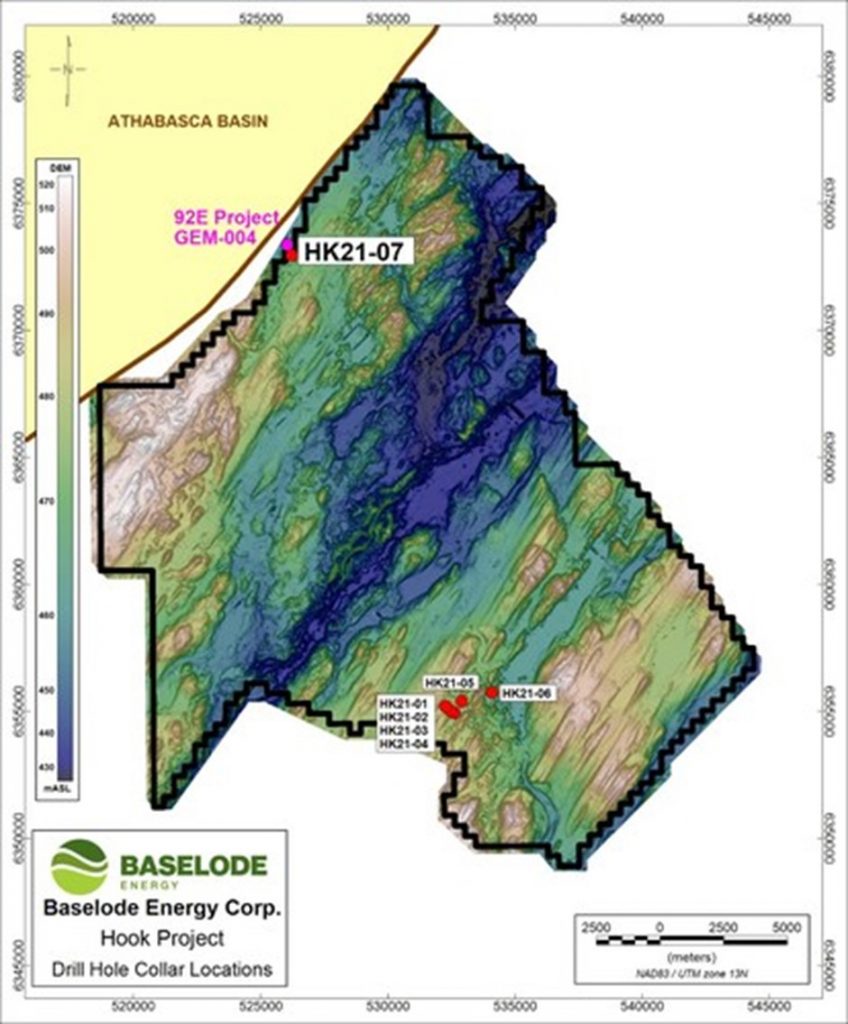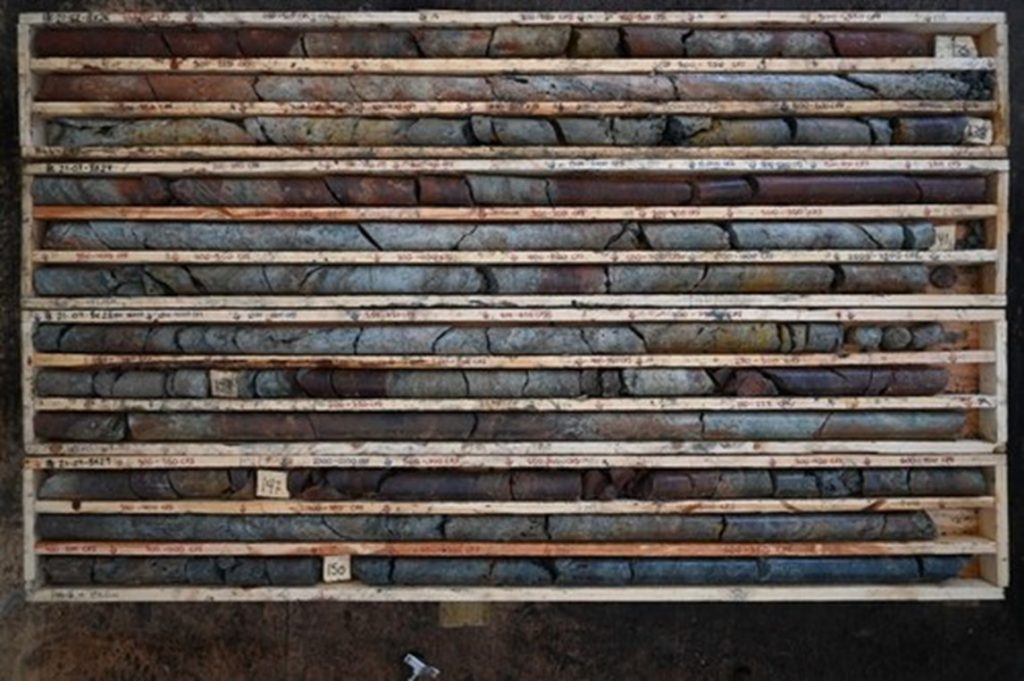
Baselode Annouces a New Uranium Discovery: Drills 16.2 Metres of Elevated Radioactivity in First Drill Program on the Hook Uranium Project
Baselode Energy Corp. (TSX-V: FIND) (OTCQB: BSENF) is pleased to announce that it has intersected a wide zone of elevated radioactivity in the first drill program on its Hook Uranium project, Athabasca Basin area, northern Saskatchewan (see Figure 1).
Drill hole HK21-07 was the first drill hole in the Ackio target area on Hook. This discovery drill hole intersected 16.2 metres of continuous elevated radioactivity (i.e., >300 cps*) starting at 133.8 m drill hole depth (~115 m vertical depth from surface) within a massive structurally-controlled hydrothermal alteration envelope that exceeds 250 m thickness (see Figure 2).
“This is an exciting discovery for Baselode. We believe this discovery is part of a new and large uranium system within the Athabasca Basin area. These results are a testimony to our Athabasca 2.0 thesis and we remain eager to deliver more exciting results from the Ackio target area as drilling progresses,” said James Sykes, CEO and President of Baselode.
The radioactive interval averages 642 cps and includes multiple intersections of >1,000 cps;
- an average of 3,900 cps over 0.5 m at 138.8 m, which also includes a 0.1 m interval of 12,500 cps,
- an average of 2,000 cps over 0.9 m at 142.0 m, and
- 2,200 cps over 0.2 m at 147.2 m.
“The widespread basement alteration we’ve intersected in HK21-07 reflects a large hydrothermal fluid system that could be fertile for high-grade uranium mineralization which is demonstrated with radioactivity >10,000 cps in the Ackio area. We’re also excited to have intersected Athabasca sandstones outside the previously known basin margin. This provides us with exploration targets for discovering unconformity-style mineralization just 50 metres below surface at Ackio,” said Cameron MacKay, Baselode’s Projects Manager.
Expansion of the Current Hook Drill Program
Due to the encouraging results at Ackio, Baselode will continue the current drill program on its Ackio target for as long as weather conditions permit. The Company is expanding the drill program from 2,500 to a minimum of 3,500 m with drill holes now ranging from 200 to 500 metres drill hole depth. The drill program is operated with helicopter support to lessen any ground-induced environmental impacts within the project area. Updates from the expanded drill program will be released in the coming weeks.
Ackio Target Area
Drill hole HK21-07 intersected a sequence of Athabasca sandstone immediately beneath glacial overburden at 35.0 m drill hole depth. The sandstone shows signs of classic Athabasca sandstone uranium deposit alteration styles including pervasive bleaching, secondary hematite and other oxidized-alteration overprints, as well as hematite alteration along faults. The unconformity between sandstone and basement rocks was intersected at 59.7 m drill hole depth. The basement rocks are strongly altered from the UC down to ~300 m drill hole depth. Basement alteration consists of predominant and pervasive chlorite alteration with clay alteration and hematite, which resemble alteration envelopes proximal to known Athabasca basement-hosted uranium deposits. The drill hole was stopped at 471 m drill hole depth. See Table 1 for drill collar information.
Drill hole HK21-07 is located approximately 450 m southeast from the recent discovery drill hole (GEM-004) by 92 Energy (ASX: 92E) on their adjacent Gemini project. Baselode believes that these two discovery drill holes are part of the same structural system, suggesting a large and widespread fertile system for uranium mineralization that remains open for drilling in all directions.
The Ackio-GEM area is located 30 km southeast of well-established infrastructure including an all-season road and powerline that run between Cameco Corp.’s (TSX: CCO) and Orano’s joint venture McArthur River mine and Key Lake Uranium mill. The Ackio-GEM area is 70 km northeast of the Key Lake mill.
Beckett Target Area
Seven drill holes (HK21-01 throuh HK21-06A, including abandoned drill hole HK21-06) were completed in the Beckett target area. A total of 2,069 m were completed in the seven drill holes down to depths between 206 m and 480 m. Drill holes HK21-01, HK21-03, and HK21-04 all intersected elevated radioactivity within quartzo-feldspathic pegmatite rock types, with some radioactivity in drill hole HK21-01 directly associated with fractures coated with yellow secondary uranium-bearing minerals between 126.9 and 139.5 m drill hole depths (~110 to 120 m vertical depth from surface). Drill holes HK21-01 through HK21-04 also intersected structural intervals up to 10 m wide with significant hematite, chlorite and clay alteration styles similar to Ackio drill hole HK21-07. See Table 1 for drill collar information.
“The yellow uranium-bearing minerals are a hydrous form of uranium, suggesting that the necessary conditions to mobilize uranium was present locally. In addition, we’ve intersected hematite-rich fault zones with remobilized clay-altered fractures, similar to those observed at Ackio, which could be distal parts to structures that may have carried and deposited uranium nearby. We remain excited with the exploration potential that exists at the Beckett target area,” said James Sykes.
| NOTES: | |
| 1. | cps* = “counts-per-second”, as measured with a handheld RS-125 Gamma-Ray Spectrometer/Scintillometer. The reader is cautioned that Baselode uses scintillometer readings as a preliminary indication of the presence of radioactive materials (uranium, thorium and/or potassium), and that scintillometer results may not be used directly to quantify or qualify uranium concentrations of the rock samples measured. |
| 2. | The Company considers all RS-125 readings greater than 300 cps to be considered elevated radioactivity, with background radioactivity measuring between 50 to 100 cps. |
| 3. | “continuous elevated radioactivity” means drill core length with no greater than 2.0 m of consecutive drill hole length measuring less than 300 cps. |
| 4. | All reported drill hole intervals are drill core lengths and do not represent true thicknesses which have yet to be determined. |
About Baselode Energy Corp.
Baselode currently controls 100% of approximately 207,000 hectares for exploration in the Athabasca Basin area, northern Saskatchewan, Canada. The land package is free of any option agreements or underlying royalties.
Baselode’s Athabasca 2.0 exploration thesis is focused on discovering near-surface, basement-hosted, high-grade uranium orebodies outside of the Athabasca Basin. The exploration thesis is further complemented by the Company’s preferred use of innovative and well-understood geophysical methods to map deep structural controls to identify shallow targets for diamond drilling.
QP Statement
The technical information contained in this news release has been reviewed and approved by Cameron MacKay, P.Geo., Projects Manager for Baselode Energy Corp., who is considered to be a Qualified Person as defined in “National Instrument 43-101, Standards of Disclosure for Mineral Projects.”
FIGURE 1: Hook project overview; Ackio (HK21-07) and Beckett (HK21-01 to HK21-06) target areas, including 92 Energy’s Gemini (GEM-004) discovery drill hole (pink circle)
FIGURE 2: Elevated radioactivity and alteration intersected between 133.8 m and 150.0 m in drill hole HK21-07
TABLE 1: Diamond drill hole (DDH) collar information
| DDH | Target Area | Easting | Northing | Elevation | Azimuth | Dip | EOH | Radioactivity (>300 cps) |
| HK21-01 | Beckett | 532,270 | 6,355,205 | 481 | 135 | -60 | 339 | 410 cps over 6.3 m at 126.9 m |
| 310 cps over 0.25 m at 137.1 m | ||||||||
| 329 cps over 11.23 m at 139.5 m | ||||||||
| 460 cps over 0.3 m at 218.0 m | ||||||||
| HK21-02 | Beckett | 532,270 | 6,355,205 | 481 | 135 | -45 | 318 | No significant results |
| HK21-03 | Beckett | 532,445 | 6,355,065 | 491 | 135 | -60 | 480 | 333 cps over 46.3 m at 247.7 m |
| 500 cps over 0.1 m at 406.9 m | ||||||||
| HK21-04 | Beckett | 532,620 | 6,354,940 | 479 | 135 | -60 | 270 | 321 cps over 13.3 m at 205.6 m |
| HK21-05 | Beckett | 532,900 | 6,355,400 | 478 | 135 | -60 | 363 | No significant results |
| HK21-06 | Beckett | 534,121 | 6,355,758 | 470 | 115 | -60 | 93 | N/A – Abandoned |
| HK21-06A | Beckett | 534,121 | 6,355,758 | 470 | 115 | -60 | 206 | No significant results |
| HK21-07 | Ackio | 526,245 | 6,372,955 | 467 | 270 | -60 | 471 | 333 cps over 3.3 m at 127.1 m |
| 642 cps over 16.2 m at 133.8 m | ||||||||
| 8 DDH | 2,540 | 4 DDH | ||||||
| NOTES: East and North units are metres using NAD83 datum, UTM Zone 13N | ||||||||
| Elevation is recorded as “metres above sea level” | ||||||||
| EOH = End of hole, measured in metres | ||||||||
| Radioactivity intervals do not contain greater than 2.0 m of consecutive dilution (i.e., <300 cps) > | ||||||||
MORE or "UNCATEGORIZED"
Red Pine Provides Further Update On Assay Results for Wawa Gold Project
Red Pine Exploration Inc. (TSX-V: RPX) (OTCQB: RDEXF) further to... READ MORE
Getty Copper Intersects High-grade Copper Mineralization in the First Drill Holes, Glossie Occurrence, Highland Valley Area, Southern B.C.
Getty Copper Inc. is pleased to report drill results from the fir... READ MORE
Guanajuato Silver Announces Closing of C$11.35 Million Brokered Financing
Guanajuato Silver Company Ltd. (TSX-V:GSVR) is pleased to announc... READ MORE
Hot Chili Closes A$24.9 Million Private Placement and Announces Full Underwriting of A$5 Million Share Purchase Plan
Positioning for Near-Term, Meaningful, Copper Production H... READ MORE
Barksdale Announces San Javier Preliminary Economic Assessment
Barksdale Resources Corp. (TSX-V: BRO) (OTCQX: BRKCF) is pleased ... READ MORE













